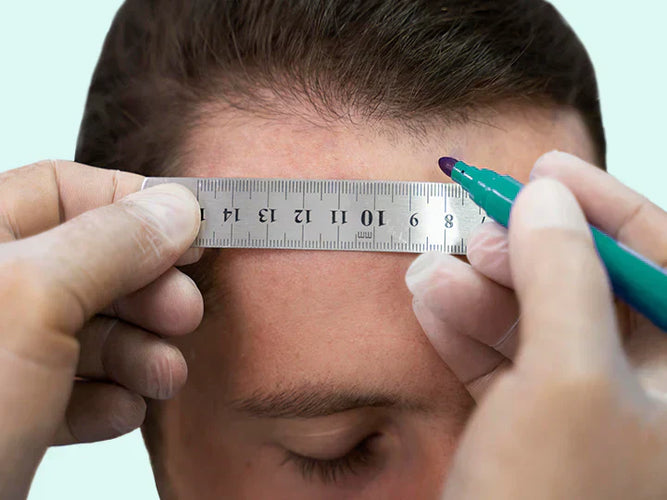- How much does your hair grow per month on average?
- What to expect after 1, 3 or 6 months of hair growth
- Why does your hair grow faster or slower than average?
- How to measure how fast your hair is growing
- Hair Growth Calculator: find your personal growth speed
- Calculate your personal hair growth speed
- What if your hair barely grows?
- Conclusion
- Sources
Sometimes it feels like your hair just isn’t growing and that can be frustrating. Maybe you’re trying to grow it out, recover from hair loss, or you’re simply curious. So, how fast does hair really grow? In this blog, you’ll learn the average hair growth rate, why your hair might grow faster or slower, and how to support healthy hair growth. With clear tips, simple measuring methods, and a helpful growth calculator, we’ll guide you step by step.
How much does your hair grow per month on average?
On average, scalp hair grows about 1 to 1.25 centimetres per month. That’s around 0.3 to 0.4 millimetres per day, or 12 to 15 centimetres per year.
| Time period | Average hair growth in cm |
| Per day | 0.3 - 0.4 mm |
| Per week | 2 - 3 mm |
| Per month | 1 - 1.25 cm |
| Per year | 12 - 15 cm |
Table 1: overview of hair growth speed per time period
But what do these numbers numbers really mean? And do they apply to you? These averages apply to people with a healthy and active hair growth phase (called the anagen phase, see image 1). The speed can vary depending on your age, health, hair type, and care routine.
Hair growth cycle
Did you know that hair only grows during the anagen phase of the hair growth cycle? This phase lasts around 2 to 5 years. The longer it lasts, the longer your hair can grow. After this, your hair goes through a transition and resting phase, during which it no longer grows and eventually falls out.
Hair begins growing beneath the skin, in the hair root. That means the first few millimetres of new hair are not visible right away. Because of that, it can sometimes feel like your hair is growing slower than it really is.

Image 1: The stages of the hair growth cycle
Read more about this topic in our blog on the hair growth cycle.
What to expect after 1, 3 or 6 months of hair growth
Hair growth takes time and patience. When you start using hair growth products or switch to better hair care, it’s normal to expect quick results. To avoid disappointment, we recommend setting realistic expectations. This timeline shows you what kind of hair growth you can expect during the first six months.
Hair growth after 1 month
- Your hair has grown about 1 cm
- The change is often not yet visible, especially with curly or damaged hair
- Hair may already feel stronger, softer or shinier with better care
- Your hair follicles are becoming more active thanks to better nutrition, supplements or scalp care
Tip: Start measuring now or take monthly photos, soon you’ll see the difference.
Results after 3 months
- Your hair is now about 3 cm longer
- New hairs are coming out of the resting phase, so volume or density may increase
- If you started a routine with supplements and topical products (used directly on the skin or scalp), you’ll start to see visible effects
- Many people notice less hair loss and a healthier hairline
- You’ll likely see a difference in the mirror, and feel it too
Hair growth after 6 months or more
- Your hair has grown around 6 to 8 cm on average
- Clear improvement in length, thickness and overall condition
- If you had hair loss, you’ll likely see visible improvement now
- Long-term care is now really paying off
Important: hair growth is a slow process. Patience, consistency and the right care make a big difference in the long run.
Why does your hair grow faster or slower than average?
The rate of hair growth is different for everyone. Some people gain centimetres with ease, while for others it’s more difficult. Several factors can affect how fast your hair grows. Part of it is genetic, but your lifestyle also plays a role. In the table below, you can clearly see which factors may speed up or slow down your hair growth.
| Factor | Effect on Hair Growth | Can you influence it? |
| Health & balance | Deficiencies in iron, zinc or thyroid problems can slow down hair growth | Yes. A blood test can help. You can prevent deficiencies prevent deficiencies with nutrition or supplements. |
| Lifestyle & habits | Poor sleep, high stress or crash diets can disturb your hair growth cycle | Yes. Improve rest, diet, self-care and try anti-stress supplements. |
| Genetics & ethnicity | Your hair type, growth phase and maximum length are mostly genetic and vary by ethnicity | Partly. Supplements may help stimulate growth. |
| Environment | Climate, UV light or air pollution can affect growth and hair quality | Limited. Protection and the right care for hair and scalp help. |
| Life stage & hormones | Menopause, pregnancy or ageing can slow or stop hair growth temporarily | No. It’s biological, but hair growth can still be supported. |
Table 2: overview of hair growth rate factors
Some factors, like age or genetics, can’t be changed. But by taking good care of yourself and your scalp, you can still get the most out of your natural hair growth potential. Take a look at our Neofollics Stimulating Hair Growth productline to support your hair growth.
Are you going through a phase where your hair is growing slower or falling out, like after pregnancy or around menopause? Then your hair growth may be temporarily affected. Read our blogs about female hair loss and male hair loss to learn more about possible causes and what to do about them.
Is your body in balance?
Some factors from the table above are within your control, like eating healthy. But even with a good diet, your hair might not grow faster. When your body is under stress, it uses more energy to stay balanced. That energy is then not available for less essential functions, like growing hair.
Hair grows only when your body has enough energy and nutrients. Since hair growth is not a top priority for survival, your hair follicles get attention only if there’s enough energy left after supporting vital organs like your heart, brain and immune system.
When your body is out of balance, due to vitamin deficiency, chronic stress or hormonal changes. Your hair is often one of the first places where this becomes visible. It may grow more slowly or feel thinner.
What can you do?
- Not sure about your health? Get your blood levels tested by a doctor (e.g. iron, vitamin D, thyroid).
- If you have a deficiency, supplements and a healthier lifestyle can help support your hair from within.
- Also care for your scalp and hair properly to keep your follicles strong and ready to grow.
How to measure how fast your hair is growing
Curious to know how much your hair has grown over time? With these three simple methods, you can easily track your hair growth and see clear results after a few weeks or months.
Method 1: Measure regrowth after hair dye
Do you colour your hair regularly? Then this method is for you. Wait a few weeks after dyeing your hair and check the regrowth at your roots. Measure the length of the regrowth and divide it by the number of days since you dyed it. This gives you a good estimate of your personal hair growth rate.
Method 2: Monthly photos and length check
Take a photo of the back of your hair every month, always in the same setting. Ask someone to help you or use a tripod or timer on your phone. Use a measuring tape or fixed reference point (like your shoulder or a piece of clothing) to compare your hair length over time.
If you have shorter hair, use a ruler or triangle ruler instead. And make sure the camera is always close enough for clear comparison.
Method 3: Use a measuring tape and growth tracker
This method is similar to the previous one, but instead of taking photos, you write down your results. Not everyone likes taking pictures of themselves, so this is a great alternative. It also helps you measure your personal hair growth rate more accurately.
Here’s how to do it: use a measuring tape and measure your hair from the same spot every day, week, or month. Choose one fixed point on your head – for example, from your forehead to the tip of a strand at the front, or from the crown to the tips at the back. Write down your measurements.
By tracking the difference in length each time, you get a clear picture of how fast your hair grows.
Hair Growth Calculator: find your personal growth speed
Average hair growth gives you a general idea, but everyone is different. That’s why we created the Hair Growth Calculator. Based on your age, hair type, health, and lifestyle, it gives you a personal estimate of how much your hair grows per month.
It’s especially useful if you're starting with hair growth products and want to track progress. Measure your hair growth before and after 6, 9, or 12 months to see if the products are really working for you.
Calculate your personal hair growth speed
Find out how many centimetres your hair grows on average per month – based on age, hair type, lifestyle and more.
What if your hair barely grows?
If your hair grows much slower than average, it’s time to look a little deeper. Sometimes hair grows slowly, but other times it only seems that way. For example, when your hair breaks at the ends or your hair growth cycle is disrupted.
To find the right solution, you first need to understand the cause. This could be related to nutrient deficiencies, stress, hormones, genetics, or how you style and treat your hair.
Conclusion
How fast your hair grows depends on many factors, from your hair growth cycle and health to your care routine. On average, you can expect about 1 to 1.25 cm per month, but your personal hair growth rate may be different. By tracking your growth, understanding the key influences, and having realistic expectations, you can get the most out of your hair’s natural potential.
Sources
Medihair. (n.d.). Hair statistics: Growth, loss & restoration facts. https://medihair.com/en/hair-statistics/
O’Neill, K. (2023, February 27). How fast does hair grow? Health. https://www.health.com/how-fast-does-hair-grow-7560721
Han, J. H., Kwon, O., Sim, W. Y., Kim, J. M., Kim, M. B., Seo, Y. J., Kim, M. H., & Kim, Y. C. (2023). Analysis of hair growth rates according to gender, age, and body site using phototrichogram and photogram. Journal of Clinical Medicine, 12(3), 893. https://www.mdpi.com/2077-0383/12/3/893
This information does not replace professional medical advice. If in doubt, always consult a doctor or specialist.













